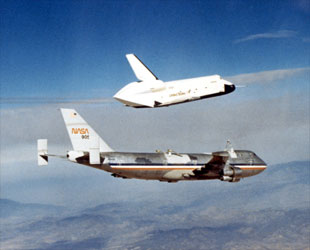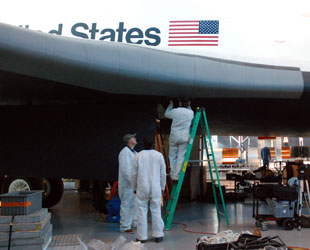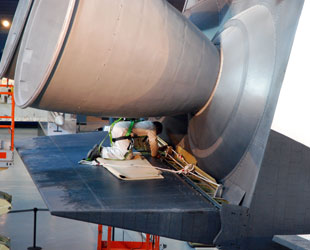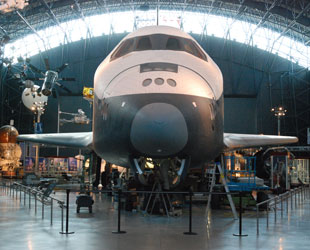March 15, 2010 — Enterprise, NASA's first space shuttle prototype, which in 1985 was delivered to the Smithsonian as a museum piece after proving that a winged spacecraft could land safely as a glider, is now being readied by the space agency for what is planned to be its final ferry flight atop a modified Boeing 747 jetliner.
Enterprise's upcoming flight comes as a result of NASA's plan to retire the three space-worthy shuttles remaining in its fleet later this year. All three are expected to be placed on public display, with one, Discovery, heading for the Smithsonian's Steven F. Udvar-Hazy Center, the annex to the National Air and Space Museum in Chantilly, Virginia, where Enterprise has been exhibited since 2003.
"If we indeed receive a flown orbiter as expected, we can't be greedy and have two of them here so we'll need to look for a new home for Enterprise," explained curator Valerie Neal in an interview with collectSPACE.

Photo Gallery: Preparing Enterprise for flight
Though the Smithsonian and NASA have yet to choose a new museum for OV-101 (the space agency's designation for Enterprise), or whether it will be placed on permanent loan from the national collection or provided outright to its new home, the two organizations recognized the need now to make sure that Enterprise could be safely moved.
"The people who are starting to work on the logistics for flying the orbiters to their different new homes decided that they better take a good look at Enterprise and just validate that it is ferry-worthy after all these years," said Neal. "The assumption all along is that it is and a quick look assessment had indicated that yes, it is intact." Now that they're getting really serious about the possibility of a ferry flight, they wanted to take a very close look — a microscope look — at the critical features and junctures."
So an eleven-person team from NASA's shuttle operations contractor United Space Alliance (USA) was sent from the Kennedy Space Center in Florida to to the Smithsonian's Udvar-Hazy Center to "shake down" Enterprise and make sure it is ready to go.
"They have been here for two weeks and have worked their way pretty methodically all around the vehicle," Neal described. "So far, they've found everything to be in good order."
Just enough different
"There does not appear to be any type of big problem or show-stopper or anything like that," reported Neal. "This is really kind of a confidence building exercise just to make sure, because Enterprise is just enough different from the vehicles that remain that they're concerned [if] everything will fit with the equipment we're using today or is there any kind of anomaly here that we need to be aware of that will affect what our standard procedure is."
Built between 1974 and 1976 by Rockwell (now Boeing) in California, Enterprise was used for NASA's Approach and Landing Test (ALT) program, making 13 flights between February and October 1977 while attached to the modified 747 Shuttle Carrier Aircraft (SCA). During the last five of those flights, Enterprise separated from the jet at altitude and was then piloted by two NASA astronauts to a landing at Edwards Air Force Base.

Enterprise separating from NASA's modified Boeing 747 Shuttle Carrier Aircraft for an approach and landing test. (NASA) |
The prototype orbiter was later used for vibration and "fit" checks, the latter to make sure that the support facilities and launch pad was properly configured for the shuttle.
Originally, Enterprise was to be refitted for spaceflight but design changes during the construction of OV-102, named Columbia, made it impractical. Still the two shared more in common than what separated them.
"This vehicle very much closely matches the real airframe on the spacecraft," said Klint Combs, USA's manager for orbiter handling and mechanisms, who has led the team of USA technicians working on Enterprise. "They were going through the design process and they wanted to make sure that what they were designing for a spacecraft to land as a glider, they were testing what they were going to fly."
"She does resemble inside a lot like Columbia," described Martin Boyd, who as NASA's lead structures engineer for the orbiter fleet has been overseeing the work by Combs and his team. "It is unique because [Enterprise] doesn't exactly look like ours. It is structurally, but because it doesn't have all the plumbing and all the hyper-systems and all the stuff in there, we get to kind of get in there and say, 'Wow, that's what it really looks like behind all of that other stuff.'"
As similar as Enterprise may be to the other orbiters from the inside, its tiles on the outside were different enough to provide a concern for flight.
"We were somewhat concerned about the adherence of the foam," explained Combs to collectSPACE, referring to the polyurethane foam blocks that were used to replicate the appearance of the thermal heat shield tiles on the real orbiters, "so we did a bunch of pull tests to verify the bond of the foam to the aluminum skin of the vehicle. We were particularly concerned in the aft, where hydraulic systems have leaked out over the decades. The foam back there is saturated, so we were concerned that may have affected the bond but those areas passed as well."
Really good shape
Unlike the space-flown shuttles, which NASA shelters and services between flights to minimize damage by exposure to the elements, Enterprise spent much of its 30 years in the open air, either on display (it was ferried overseas for the 1983 Paris Air Show and a subsequent international tour, for example) or in uncontrolled hangars. It's therefore faced conditions not seen with the other orbiters.
"Effectively, this vehicle sat outside in the weather for three years and then another 15 years in an uncontrolled hangar, so it has had standing water in it. When we go in the wings and the aft compartment, we can see where there has been a water line three to four inches above the floor levels," described Combs.

United Space Alliance technicians reinstall a carrier panel under Enterprise's starboard, or right, wing. (collectSPACE) |
Although the Smithsonian worked to refurbish Enterprise, "preparing it better for long term preservation," as related by Neal, the prior exposure merited NASA taking a closer look at the systems and structures critical for it to return to flight, including the orbiter's attach points used to hoist by crane and mount Enterprise on the carrier aircraft; the thrust structure at its aft because that is what carries the weight from the attach points; the midbody, "all the struts and everything involved in there"; and of course the wings themselves.
"They have done everything from just doing torque tests on certain bolts to make sure they are still torqued down tight to tightening any that may have loosened, to opening up the elevons and the body flap and working through all the actuators that are inside to make sure that everything is still movable," described Neal.
"They also did some microscopic analyses," added Neal. "They brought boroscopes and they got deep inside and underneath places and looked deep in to see if they could see any signs of corrosion or any kinds of defects that might have occurred over the years."
"They brought their non-destructive test and evaluation people here and did some x-ray analysis and eddy current analysis and some magnetic particle analysis. They were looking at welds to see if critical welds were still intact or looking for welds that might have been there if certain things had been done to Enterprise over the years and they didn't find any [unexpected] welds at all, so that was a good thing."
"So it really was a thorough test," concluded Neal.

A technician reinstalls a panel on Enterprise's body flap after inspecting the flight control actuators. (collectSPACE) |
After inspecting Enterprise inside and out, the NASA and USA teams found surprisingly minor damage.
"She's in pretty good shape," Combs reported. "There are some areas of corrosion that we'll be taking a look at, probably doing some stress analysis on to make sure it is in good enough condition for a ferry flight."
"We have some struts that have been dented over the years," added Boyd. "We're going to take those back and either get them re-serviced or replaced. Other than that, it is just minor things here and there."
"For its age and where it has been outside for most of its life, it is in really good shape," said Boyd.
"You have to remember that this vehicle was built to accelerate to 17,500 miles an hour and make it into low Earth orbit, so it was designed for much higher load cases than what it'll see in ferry flight," Combs explained. "There is some degradation in some spots but it is probably well within the limits of what we expect for the ferry."
Working with history
Combs estimates that he and his team have spent almost 1,000 hours on this trip inspecting Enterprise, which as planned is just "phase one" of getting the vehicle ready to leave the ground.
"The upshot of it is that they will do a report after they get back [to Kennedy Space Center] about what they view the status of the vehicle to be and if they've seen any kind of repair that is needed or replacement that is needed," said Neal. "They will then come back again, maybe six months from now and do those repairs and then close everything out."

Photo Gallery: How to display a retired orbiter
They will also return to power and test a system critical to moving Enterprise out of the museum, let alone to its new home.
"One of the things they will come back for is retraction of the landing gear and a lowering of the landing gear, just to make sure it all works and that nothing is missing," Neal said. "The landing gear has been removed a couple of times for test and evaluation. Some parts have been left behind and some have been sent out to California to Edwards and some have been sent to Johnson [Space Center in Houston]. So they want to go through a whole cycle of retracting the gear and lowering the gear again and that means putting hydraulic fluid into the system and working against gravity to raise the gear."
As currently displayed, Enterprise is supported not by its gear, but a inconspicuous stand that bears the weight.
Once that test is completed, the vehicle is deemed ready for flight, and a new home is chosen, Neal anticipates the swap between Enterprise and Discovery to take about a week's work on the ground.
"Without having time-lined it all out, we have just a gut sense that it will take at least a week, maybe more. We would either pull Enterprise out the day before or a day or two before the 747 and the new orbiter came in, so that once we had [Discovery] offloaded we could then bring it straight into the building. Enterprise will still need to have some last minute work done to it," she said.
Enterprise's eventual departure will be poignant for Neal, who has grown a fondness for the shuttle prototype, but she expects that to be counterbalanced by the excitement of receiving a flown orbiter.
"It would be ideal maybe to have both as bookends for the shuttle program," she shared, "but that would be kind of greedy when there are so few. It is a spacecraft that we have given a lot tender loving care to, but we're willing to pass it to its next steward knowing what we have done to make sure Enterprise survives."

Enterprise has been on display in the Udvar-Hazy Center since 2003. It's exhibit will be replaced by Discovery. (collectSPACE) |
For Combs' and his team, its been "an honor" to get ready Enterprise to go to its final home.
"Honestly, it's given me goose bumps," admitted Combs. "It is part of the history of the spaceflight program and the shuttle program, and myself and all these people [working to prepare Enterprise] are in this industry, in this business because we are passionate about space exploration."
"To be able to come back and touch a piece of history and be effectively, part of its display — we have tourists coming up to us and asking us a lot of questions and we love to share our knowledge and passion for the space program with the public — it's actually an honor."
